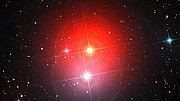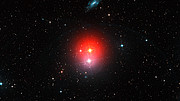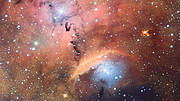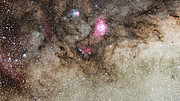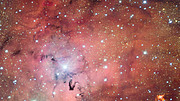Different scenarios for the aftermath of the collision of two neutron stars. At left (in the short gamma-ray burst [SGRB] scenario), a jet of material moving at nearly the speed of light is propelled from the collision site into a sphere of material initially blown out by the resulting explosion. If viewed from an angle away (off-axis) from the center of the jet, the long-term emission of X-rays and radio waves would be getting weaker. At right, the jet cannot punch out of the shell of explosion debris, but instead sweeps up material into a broad "cocoon," which absorbs the jet's energy and emits X-rays and radio waves over a wider angle. In this case, such emission is still growing in intensity, as now observed with both radio and X-ray telescopes.
Credit: NRAO/AUI/NSF: D. Berry. Hi-Res File
Three
months of observations with the National Science Foundation’s Karl G.
Jansky Very Large Array (VLA) have allowed astronomers to zero in on the
most likely explanation for what happened in the aftermath of the
violent collision of a pair of neutron stars in a galaxy 130 million
light-years from Earth. What they learned means that astronomers will be
able to see and study many more such collisions.
On August 17, 2017, the LIGO and VIRGO gravitational-wave
observatories combined to locate the faint ripples in spacetime caused
by the merger of two superdense neutron stars. It was the first
confirmed detection of such a merger and only the fifth direct detection
ever of gravitational waves, predicted more than a century ago by
Albert Einstein.
The gravitational waves were followed by outbursts of gamma rays,
X-rays, and visible light from the event. The VLA detected the first
radio waves coming from the event on September 2. This was the first
time any astronomical object had been seen with both gravitational waves
and electromagnetic waves.
The timing and strength of the electromagnetic radiation at different
wavelengths provided scientists with clues about the nature of the
phenomena created by the initial neutron-star collision. Prior to the
August event, theorists had proposed several ideas — theoretical models —
about these phenomena. As the first such collision to be positively
identified, the August event provided the first opportunity to compare
predictions of the models to actual observations.
Astronomers using the VLA, along with the Australia Telescope Compact
Array and the Giant Metrewave Radio Telescope in India, regularly
observed the object from September onward. The radio telescopes showed
the radio emission steadily gaining strength. Based on this, the
astronomers identified the most likely scenario for the merger’s
aftermath.
“The gradual brightening of the radio signal indicates we are seeing a
wide-angle outflow of material, traveling at speeds comparable to the
speed of light, from the neutron star merger,” said Kunal Mooley, now a
National Radio Astronomy Observatory (NRAO) Jansky Postdoctoral Fellow
hosted by Caltech.
The observed measurements are helping the astronomers figure out the
sequence of events triggered by the collision of the neutron stars.
The initial merger of the two superdense objects caused an explosion,
called a kilonova, that propelled a spherical shell of debris outward.
The neutron stars collapsed into a remnant, possibly a black hole, whose
powerful gravity began pulling material toward it. That material formed
a rapidly-spinning disk that generated a pair of narrow, superfast jets
of material flowing outward from its poles.
If one of the jets were pointed directly toward Earth, we would have
seen a short-duration gamma-ray burst, like many seen before, the
scientists said.
“That clearly was not the case,” Mooley said.
Some of the early measurements of the August event suggested instead
that one of the jets may have been pointed slightly away from Earth.
This model would explain the fact that the radio and X-ray emission were
seen only some time after the collision.
“That simple model — of a jet with no structure (a so-called top-hat
jet) seen off-axis — would have the radio and X-ray emission slowly
getting weaker. As we watched the radio emission strengthening, we
realized that the explanation required a different model,” said
Alessandra Corsi, of Texas Tech University.
The astronomers looked to a model published in October by Mansi
Kasliwal of Caltech, and colleagues, and further developed by Ore
Gottlieb, of Tel Aviv University, and his colleagues. In that model, the
jet does not make its way out of the sphere of explosion debris.
Instead, it gathers up surrounding material as it moves outward,
producing a broad “cocoon” that absorbs the jet’s energy.
The astronomers favored this scenario based on the information they
gathered from using the radio telescopes. Soon after the initial
observations of the merger site, the Earth’s annual trip around the Sun
placed the object too close to the Sun in the sky for X-ray and
visible-light telescopes to observe.
For weeks, the radio telescopes
were the only way to continue gathering data about the event.
“If the radio waves and X-rays both are coming from an expanding
cocoon, we realized that our radio measurements meant that, when NASA’s
Chandra X-ray Observatory could observe once again, it would find the
X-rays, like the radio waves, had increased in strength,” Corsi said.
Mooley and his colleagues posted a paper with their radio
measurements, their favored scenario for the event, and this prediction
online on November 30. Chandra was scheduled to observe the object on
December 2 and 6.
“On December 7, the Chandra results came out, and the X-ray emission
had brightened just as we predicted,” said Gregg Hallinan, of Caltech.
“The agreement between the radio and X-ray data suggests that the
X-rays are originating from the same outflow that’s producing the radio
waves,” Mooley said.
“It was very exciting to see our prediction confirmed,” Hallinan
said. He added, “An important implication of the cocoon model is that we
should be able to see many more of these collisions by detecting their
electromagnetic, not just their gravitational, waves.”
Mooley, Hallinan, Corsi, and their colleagues reported their findings in the scientific journal Nature.
The National Radio Astronomy Observatory is a facility of the
National Science Foundation, operated under cooperative agreement by
Associated Universities, Inc.
Media Contact:
Dave Finley, Public Information Officer
(575) 835-7302
dfinley@nrao.edu














